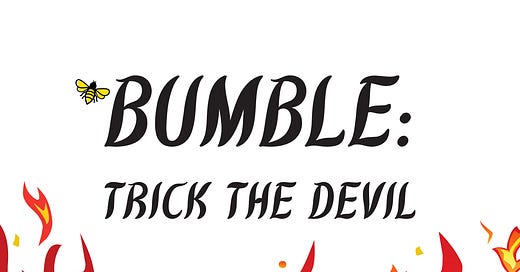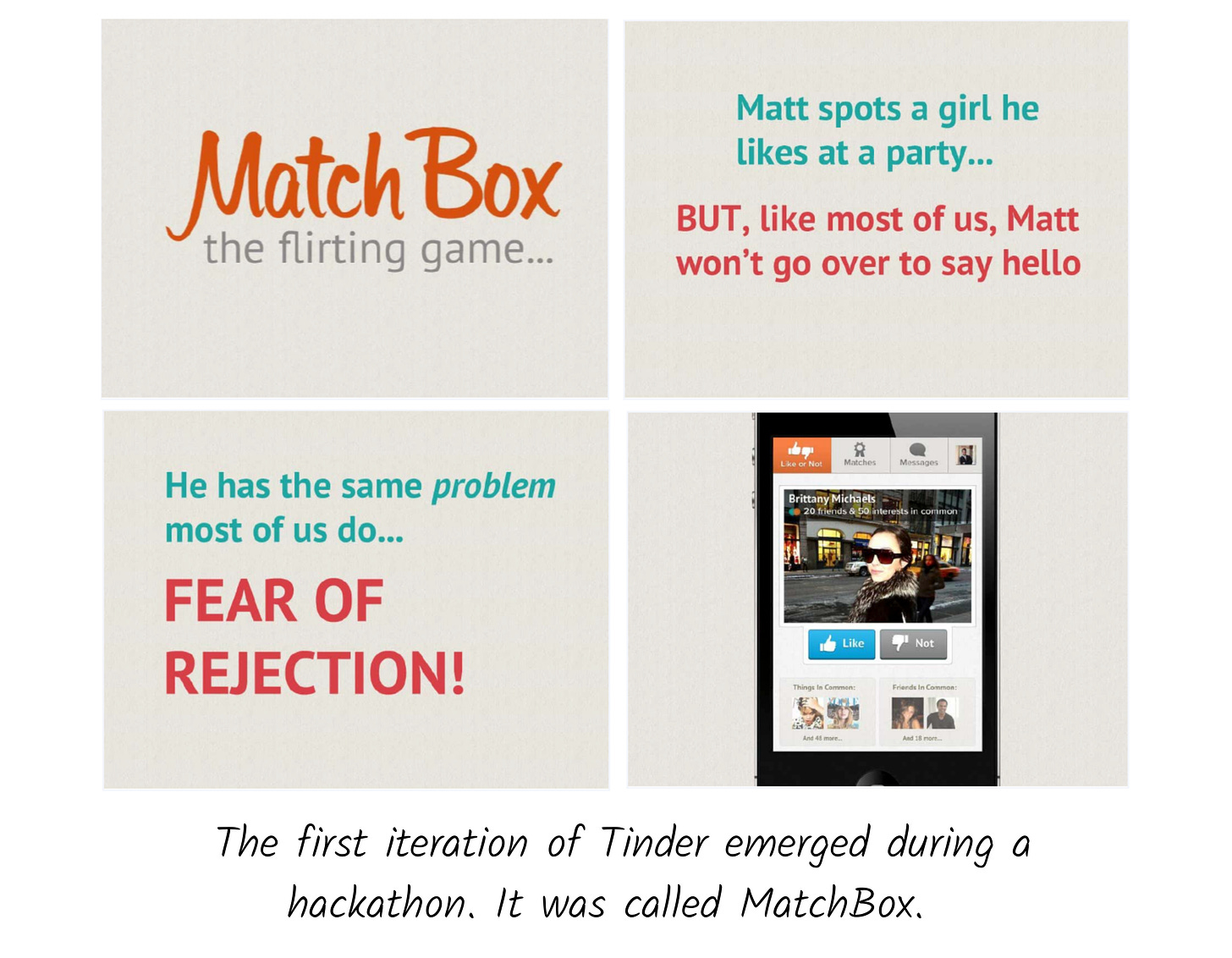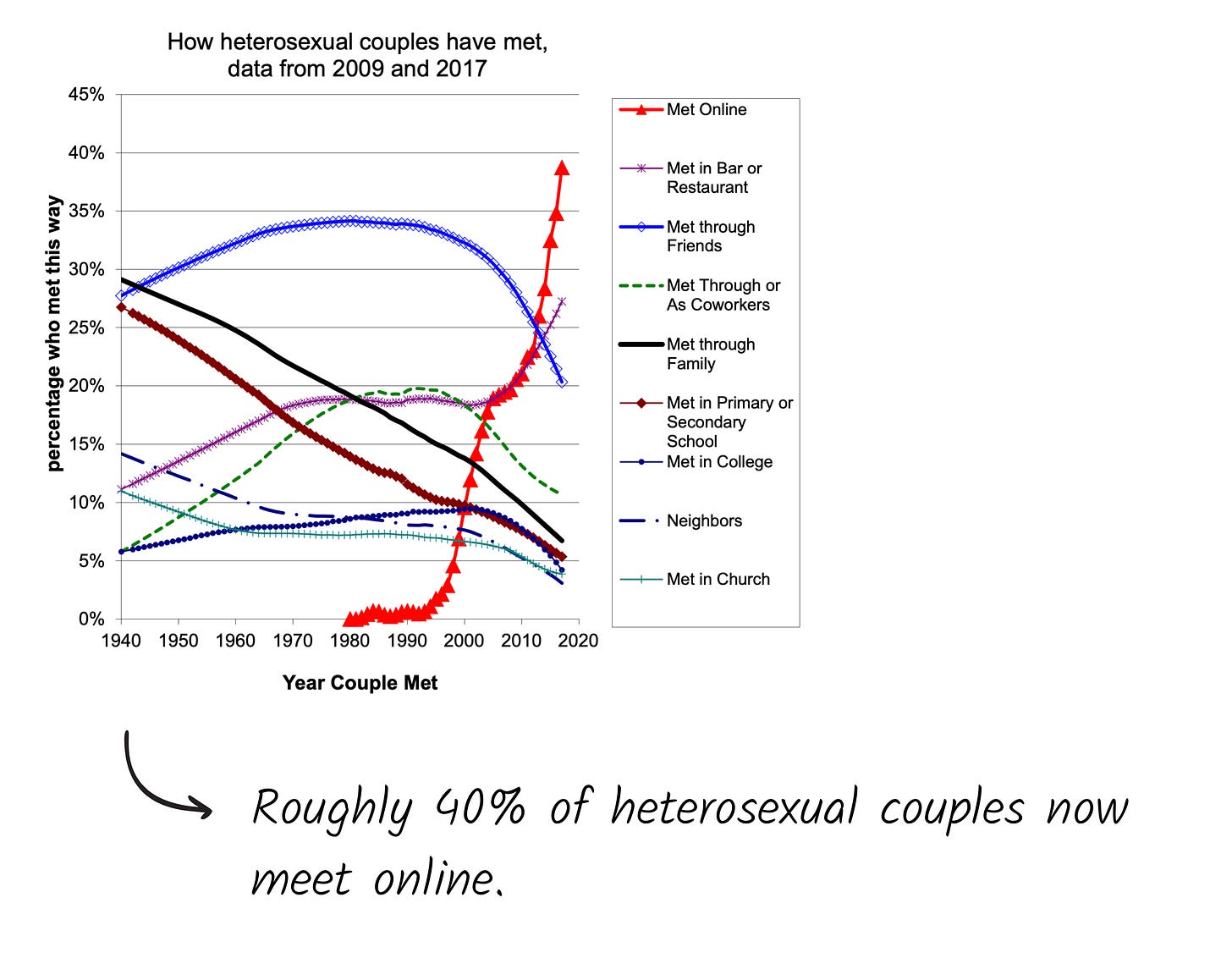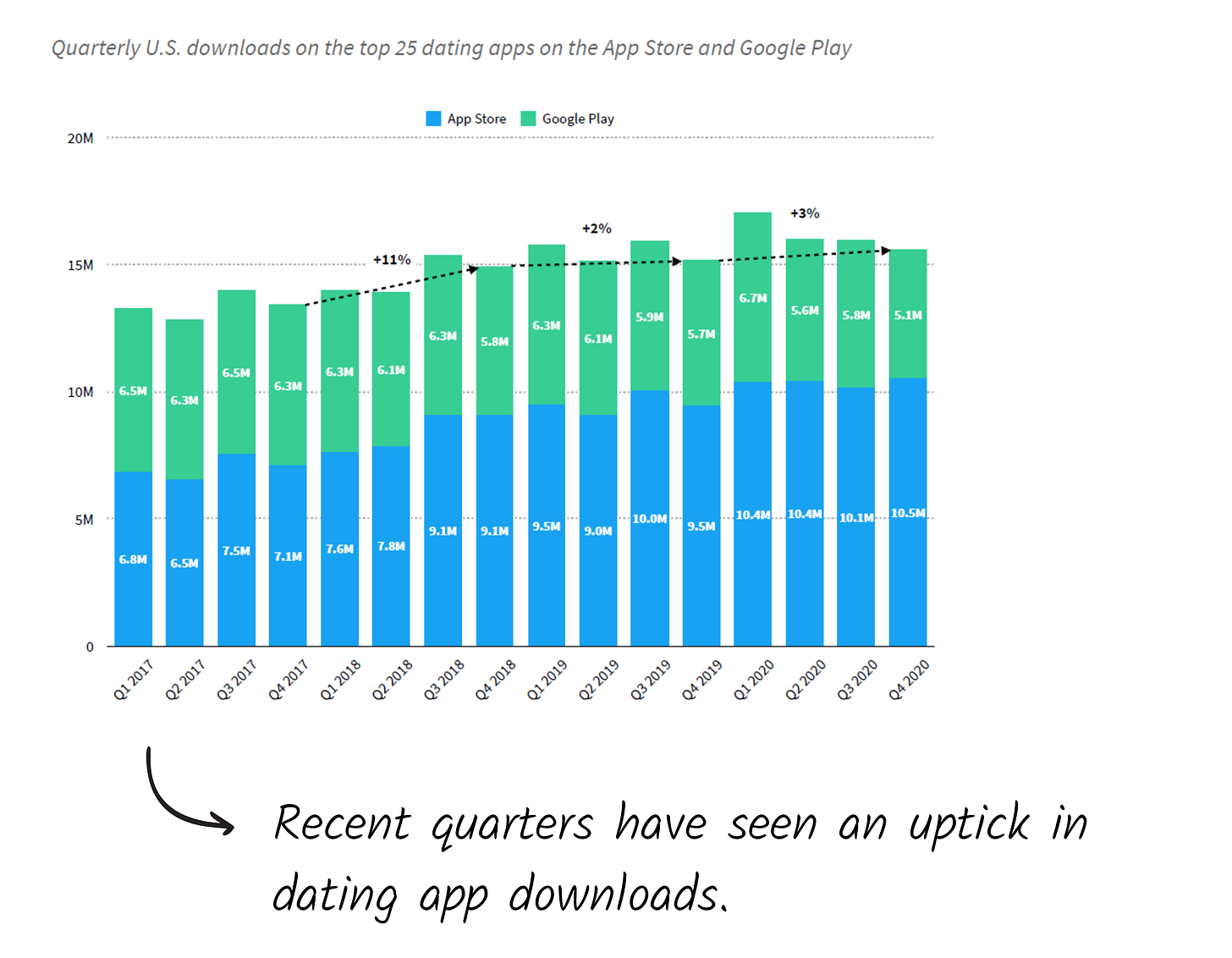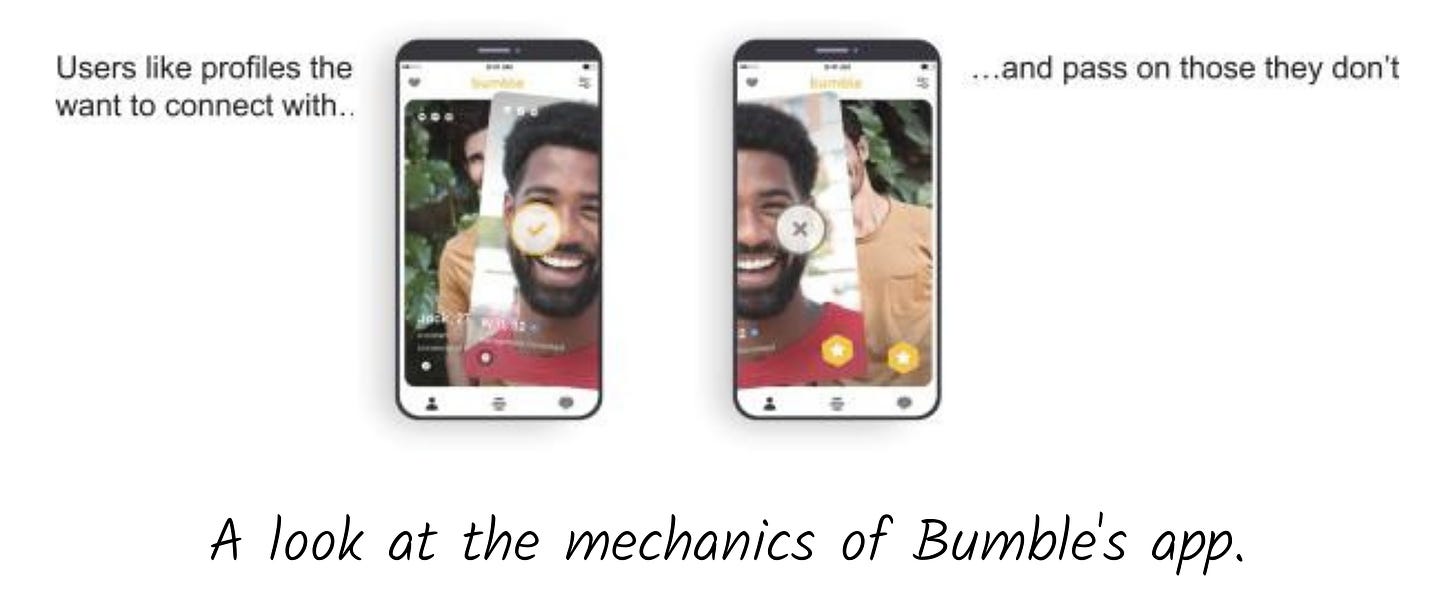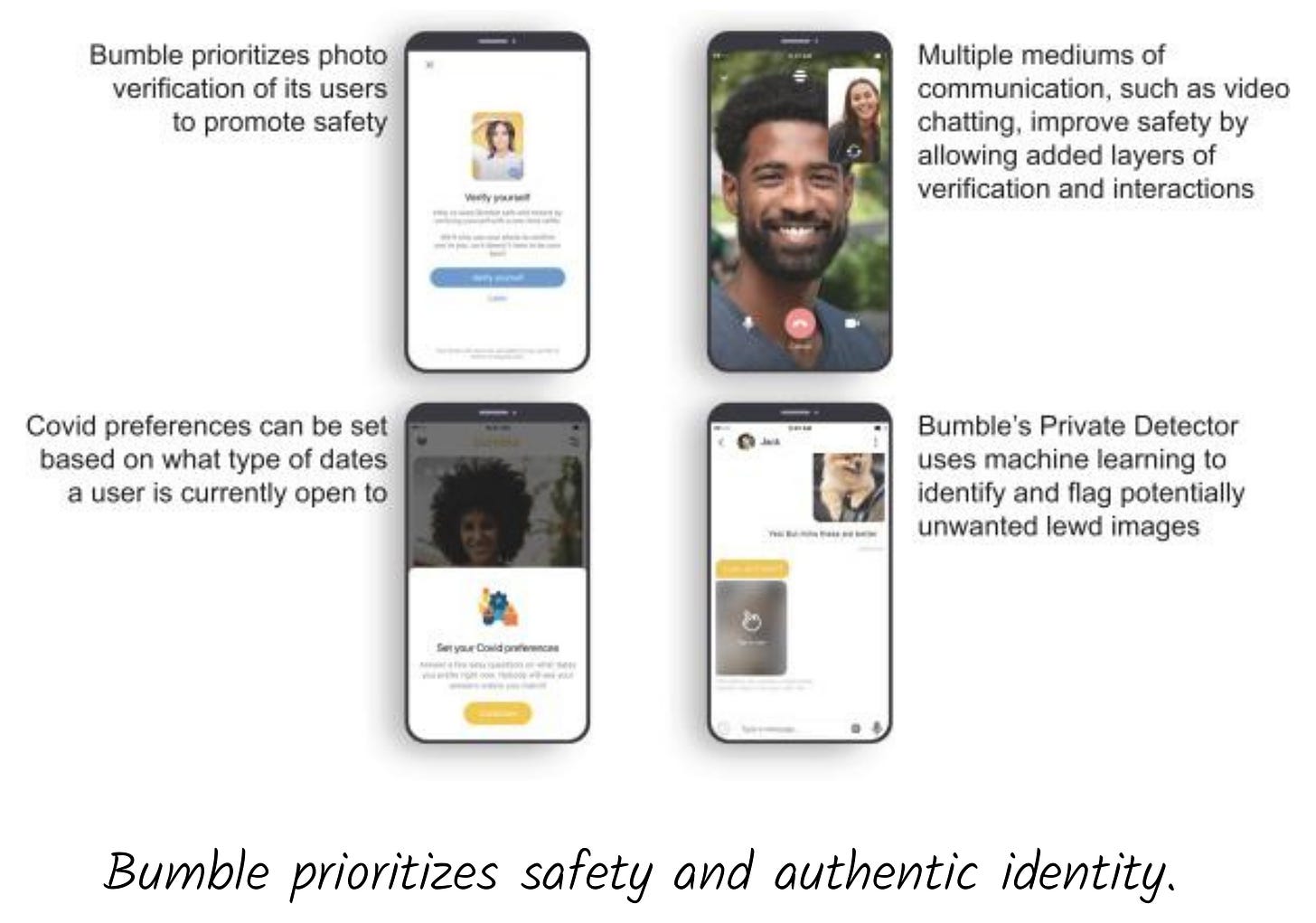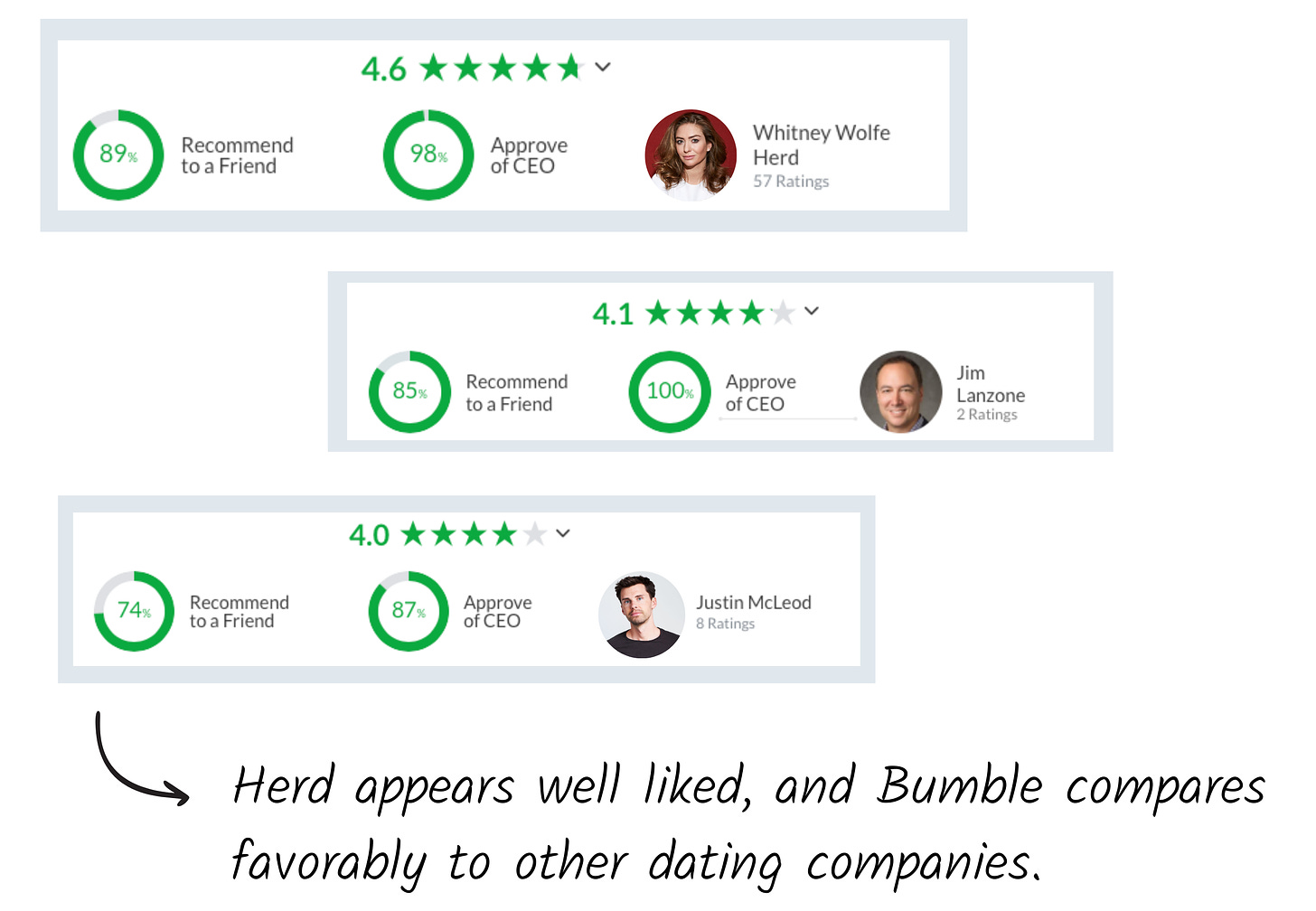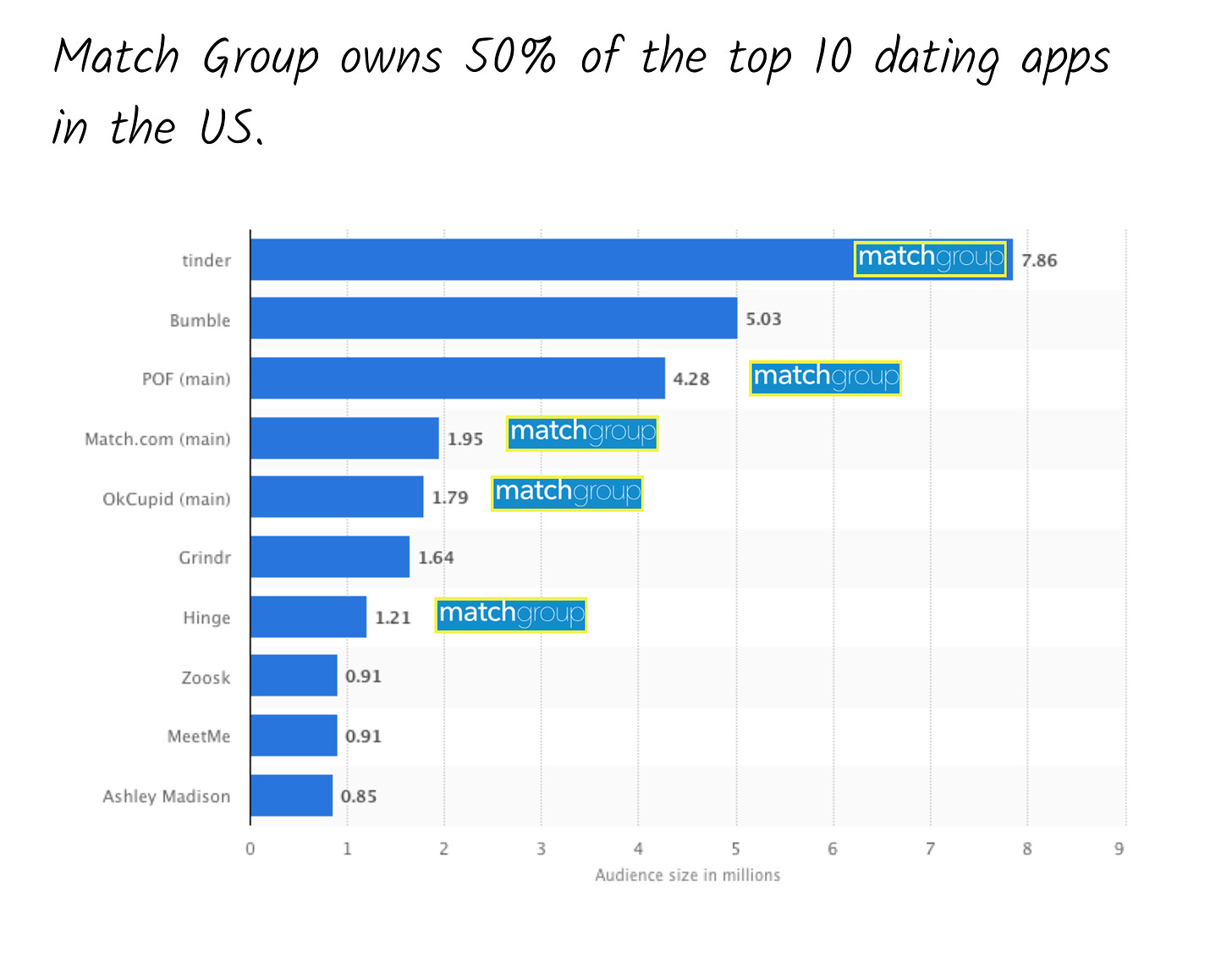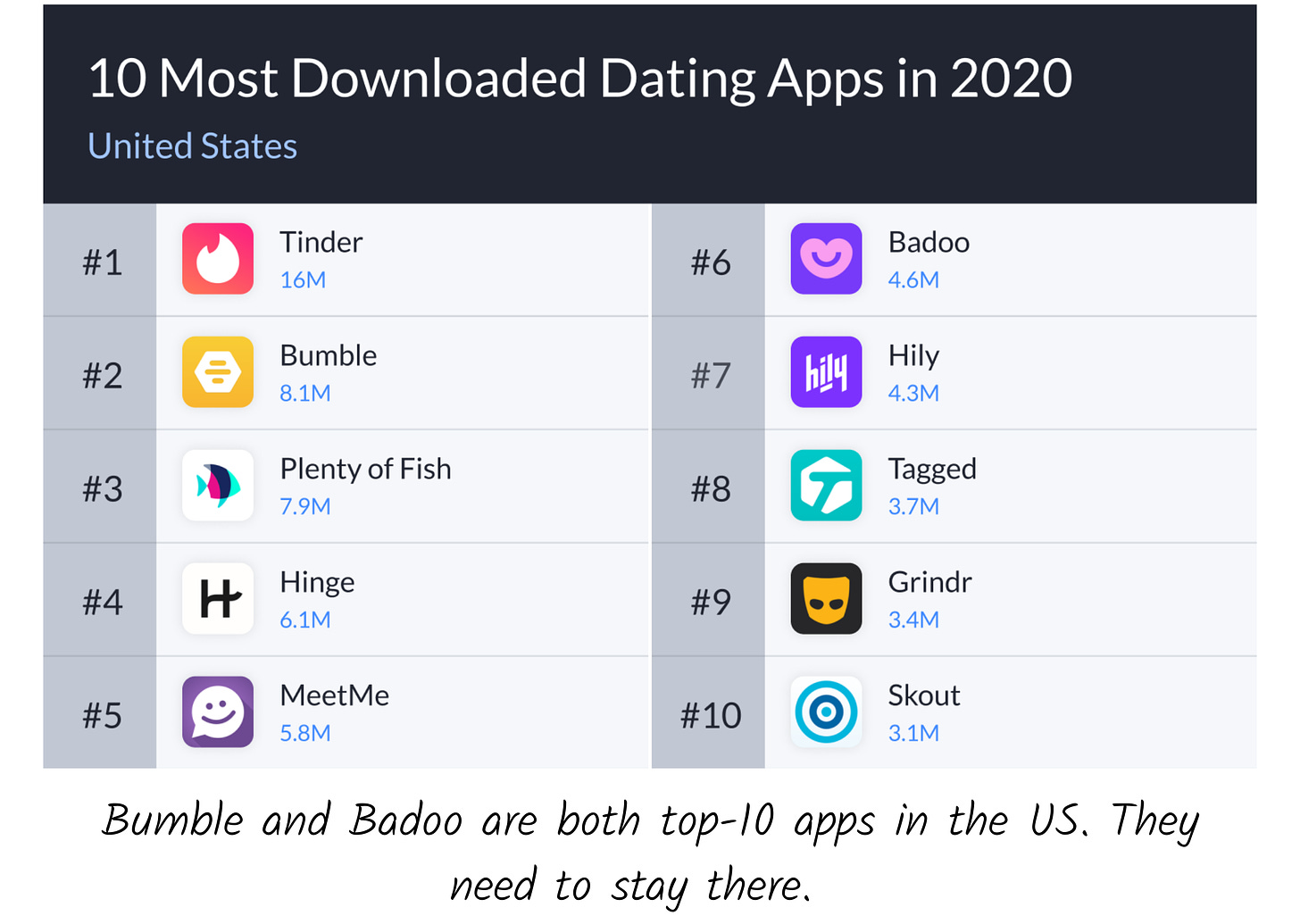Bumble: Trick the Devil
In Whitney Herd, Bumble has a CEO with a gift for triumphing in difficult circumstances.
This S-1 is presented to you by Future…
Well, that escalated quickly. After inviting readers to join me as part of Future’s challenge to complete 21 workouts in 45 days, I received a little friendly trash talk from CEO Rishi Mandal. He tweeted the following:
Love to see @mariodgabriele putting his 21-workout challenge out in the open. He was an early member. But @packyM - I still think we can take him.
As talk continued online, a three-way wager was brokered between me, Packy from Not Boring, and Rishi from Future. Whoever completes the challenge first wins 1 share of Roblox and eternal bragging rights. As someone who is very bullish on the social gaming company and enjoys gloating, I'm taking this seriously. I've stepped up my cadence and have come from behind to pull even with Packy. (He may have more minutes under his belt, but I'm all about that HIIT training). Rishi, as you can see, has a nice lead on us both, but I still think I can catch him. He has to take a break sometime...
If you want to help cheer me on and get your own body moving, I’d love for you to join me. The Future team has been kind enough to extend 25 passes to readers of The Generalist. You'll get access to remote, personalized training and actually fun workouts. Just shoot me a note, and I’ll make sure you get 45 days for free. First come, first serve. Let’s get after it.
Bumble in 1 minute
Thanks to its name alone, Bumble is sure to be one of 2021's buzziest IPOs. The dating company is hitting the public markets this Thursday. It is expected to fetch a roughly $7 billion valuation, with $416.56 million in revenue recorded over the first nine months of 2020, an increase of 14.86%.
Though many will be familiar with the bold yellow stylings of the Bumble app, that product represents just half of the story. Badoo, a dating company popular in Europe and Latin America, is also part of the package investors are buying. Not only is that company inextricably linked with the Bumble story, but it also poses fascinating questions, hinting at future geographical expansion and alluding to weaknesses in the messaging that has made a "women-first" empire tick.
Analysts
Introduction
Have you seen the devil lately?
Perhaps he alighted on your shoulder as you contemplated a second slice of chocolate cake or poured poison in your ear that burned into a hard word you wish you hadn't said and didn't mean. Maybe he manifested in some bleaker moment, a dark night of the soul, proposing an easier, sweeter path — all that was needed was a little compromise, the scrapping of pesky integrity.
He has the best lines and, at first glance, the best terms. Let's make a deal, he sings, voice as avuncular as Monty Hall himself.
You take it. Don't feel bad. We all have made some concession we wish we hadn't, chosen the road of lesser morals at one time or another. We have all made a deal with the devil, his manifestation in ourselves or others (how fun it is to tempt each other); seen a wiser, truer choice and said, to hell with it.
History is teeming with stories of this kind — the meeting with Mephistopheles, the Faustian bargain. The violinist Paganini, the composer Musard, Robert Johnson down at the Mississippi crossroads: all of them did a samba with Satan in exchange for their prodigious gifts, or so it was rumored.
Whitney Herd's devil wore Prada.
In 2019, Andrey Andreev crowed that he had "the world's biggest collection of Prada white T-shirts." (Weird flex, but ok.) By that point, he was one of the biggest power-brokers in the dating game. Not only was he suzerain of Badoo, one of Europe's largest dating apps, but he was co-founder of Bumble. Though Herd was the more vivid, public embodiment of the app, Andreev was its actually biggest shareholder. That might not have mattered had there been a more copacetic match between Badoo and Bumble — but it would prove a liability.
We're getting ahead of ourselves, though. First, let's roll back the clock to 2014.
Whitney Herd left Tinder in inflammatory circumstances. As part of her departure, Herd filed a lawsuit against her old employer, alleging sexual harassment and discrimination. That claim generated significant attention, including from Andreev. He'd only met Herd in passing but he suggested a meeting. He had an idea.
While Herd had initially set her sights on building an Instagram competitor that only allowed for positive commentary (sounds nice, to be honest), Andreev countered with a proposal of his own. Herd, he thought, should capitalize on the recognition she was receiving to make a play in the dating space. And he had just the co-founder for her: him. In exchange for 79% of the new venture, Andreev would invest $10 million and offer Badoo's infrastructure. By agreeing to the deal, Herd effectively handed majority ownership of her future business to World Vision (WV), Andreev's parent organization. WV oversaw Badoo and several smaller dating apps Andreev had also founded. While Herd would be CEO of this new company, Andreev remained in charge of Badoo and the primary steward of WV.
Perhaps Herd felt it was a fair offer at the time. Maybe she saw Andreev's formidable expertise and thought it was worth giving up 80% of uncreated business, an idea, in truth. Perhaps she hadn't heard of the wild, bacchanalian, chauvinistic culture that defined Badoo, particularly in its early days.
Whatever calculus Herd made, in hindsight, it looks like a Faustian arrangement, a tempting trade of control and alignment for short-term gain.
Deals with the devil usually follow a predictable pattern: the beguiling offer, the binding pact, the unstoppable ascent, and the inevitable comeuppance.
In the years that followed, Bumble followed that narrative to a tee. With Herd at the helm and Andreev behind-the-scenes, the new dating app took the space by storm. Not only was its bold, buzzy aesthetic a hit with consumers, its focus on empowering women struck a chord. With savvy counter-positioning, Bumble cast itself as the responsible, feminist alternative to the sloppy, hookup-centric Tinder. It rode that wave of enthusiasm to a $1 billion valuation by 2017, less than three years after launch.
Then came the fallout. In 2019, in the same blistering exposé that revealed his penchant for custom Prada tees, Forbes alleged that Andreev had created a corrosive, misogynistic culture at Badoo's London headquarters. Company parties were drug-fuelled, occasionally nude, and frequented by sex workers. New engineering builds were named after porn stars; a video circulated of one employee being fellated by a prostitute. This is without mentioning the elaborate corporate structure Andreev had constructed, primarily to avoid taxes.
To be sure, Bumble's base in Austin was a world away, both literally and metaphorically, but it was nevertheless owned by a parent company with a very different moral alignment. It was a bad look, especially for such a brand-driven business. Few revelations elicit more gleeful schadenfreude than the idealistic executive unmasked as a charlatan. (See: WeWork, Theranos.) The potential for nuclear fallout was exacerbated by Andreev's comment that he and Herd spoke up to five times a day — farewell, plausible deniability — and Herd's defense of her co-founder, "He's become my family and one of my best friends."
It seemed as if Herd was entering the inevitable final chapter. The end of most devilish deals sees the (anti) hero condemned for their unholy affiliation, greed receiving its rightful recompense.
But that's not what happened. While many CEOs might have resigned (or been forced to) under the pressure of such a PR disaster, Herd and Bumble weathered the storm. In the aftermath, Herd found an elegant, permanent solution to the threat Andreev's cavalier, undisciplined management posed. In November of 2019, just months after the incendiary Forbes piece, Blackstone acquired a majority stake in Bumble's parent company, pushing out Andreev and installing Herd at the helm. The deal valued the combined businesses of Bumble and Badoo at $3 billion.
Looking at "Bumble Inc." today — the new name for WV, the parent organization that began with Andreev — what's remarkable is how the company has seemingly added another chapter to the traditional arc. Rather than a fall from grace with Beelzebub cackling in the background, Herd, with Blackstone's help, has shepherded the conglomerate toward more natural symbiosis.
All is not solved, of course.
Badoo still feels like Bumble's slightly grimy older brother, and yes, it raises an eyebrow to hear the filing discuss the importance of "building a platform...designed to be safe and empowering for women" when said platform's co-founder concocted the opposite environment. It's reasonable to still wonder: how have Badoo and Bumble stayed together so long? After all that has happened, after all their differences, how have they endured?
Yet, here they are. Just at the point where one would have expected more jitteriness to creep into the relationship — the onset of the seven-year itch — Bumble and Badoo seem stronger than ever. Ironically, the key to this new unity is the same one that has made Bumble what it is today: give power to the woman. With Andreev and Badoo leading the way, this felt like a toxic company lagging behind market trends; with Herd and Bumble at the fore, investing looks a considerably more tempting proposition. (Aside: the greatest trick Bumble's S-1 ever pulled? Convincing us Andreev never existed. He gets 0 mentions.)
Whitney Herd has tricked the devil. Having braved Tinder's flames and Badoo's indignities, she emerged on the other side of the Satanic bargain in charge, in demand, and more vital to the business than ever. Through grit and a miraculous marketing sense, she has consistently turned bad hands into winning ones.
In short, she even knows how to give the devil a little hell.
Number of mentions in S-1
Bumble: +1,000
Whitney Wolfe Herd: 105
Badoo: 196
Women: 90
Blackstone: 69
Bumble Bizz: 14
Bumble BFF: 14
Facebook: 13
Match Group: 6
Tinder: 1
Andrey Andreev: 0
Bumble's history
There's some confusing terminology at play in the S-1 filing. First called World Vision, then called MagicLab, the parent company that owns both Bumble the app, and Badoo, is now named...Bumble. Or specifically, "Bumble Inc." That makes sections like this one something of a semantic question.
Where does Bumble's history begin? With Badoo, almost ten years before Herd even considered building a new dating app? With that fateful meeting between Andreev and Herd? Or some other critical moment along the companies' interlocking timelines?
To simplify matters and because we've covered a bit above, we'll dig into the respective histories of Bumble the app here, moving to Badoo afterward.
So, where does that story begin? We think it starts at Hatch Labs, the startup incubator of digital conglomerate IAC.
In January of 2012, Sean Rad was hired as the GM of Cardify, a credit card loyalty business Hatch was spinning up. Just a few months later, Whitney Herd joined as a field marketer for the budding company. But development on Cardify hit a snag, with Apple delaying the company's App Store launch. As that project floundered, Rad and the team, including Herd, switched gears, focusing on a new product called MatchBox.
Described in a deck to IAC executives as "the flirting game," MatchBox had a few powerful features: it leveraged mobile phones, localized potential matches, and required double opt-ins. Those attributes were meant to reduce the "fear of rejection," serving up a parade of viable, vetted matches in your local area. (Interestingly, the notorious "swipe" functionality was absent; instead, you voted via thumbs-up and thumbs-down buttons.)
Herd played a vital role in the transformation of MatchBox from a skunkworks project created during a hackathon to Tinder, the most popular dating app on the planet. Her role leading the marketing charge on college campuses brought the young, beautiful, and popular to the new app. That was pivotal to Tinder feeling different than other apps, removing stigma, and encouraging the younger generation to view online dating in a new light. Herd's work can be considered one of the most effective grassroots marketing campaigns in internet history without exaggeration.
As we mentioned above, Herd's time with Tinder ended under inauspicious circumstances. But it did not take her long to begin exacting revenge. With Andreev's help (for all his flaws as an executive, he certainly understood the space), Herd started building Bumble. Or rather, Merci as she called then. The premise of the product was dead-simple: let women make the first move. Gender imbalances plague heterosexual dating — guys send hundreds of messages that rarely get responses and often go unread, girls get inundated. The asymmetry leads to frustration on both sides and contributes to escalating bad behavior.
Bumble short-circuited that dangerous dynamic before it started. The company's elegant and powerful product innovation did away with one of the biggest headaches in dating and radically reduced the toxicity that plagues online dating.
As alluded to earlier, that sell proved popular. Bumble quickly rocketed through the dating ranks, accumulating 1 million users in its first year, and 12 million by 2016. That same year, the company introduced Bumble BFF, a way for women to find platonic friendships. In 2017, with users now at 22 million, Bumble Bizz was introduced, Herd and Co.'s first attempt to conquer networking. While neither of these experiments seems to have produced much in terms of traffic or revenue, they bolstered the feeling that Bumble was more than just another dating app — it was a movement.
Herd discussed the mission of the company in a Vanity Fair interview:
If you look at where we are in the current heteronormative rules surrounding dating, the unwritten rule puts the woman a peg under the man—the man feels the pressure to go first in a conversation, and the woman feels pressure to sit on her hands... If we can take some of the pressure off the man and put some of that encouragement in the woman's lap, I think we are taking a step in the right direction, especially in terms of really being true to feminism. I think we are the first feminist, or first attempt at a feminist dating app.
This emotional resonance was bolstered through improvements to the core app, too. As the company is keen to mention multiple times in its S-1 filing, Bumble leverages machine learning to blur lewd images. Technological advancements were allied with political ones; Bumble has been an active advocate for policies protecting against unwanted photos of this kind. It has also partnered with the Anti-Defamation League to remove users that sported hate symbols in their profile.
Today, Bumble Inc. reports over 40 million monthly active users (MAUs). The Bumble app brings in 12.3 million, and Badoo drives 28.4 million. Revenue surpassed $400 million over the first nine months of 2020.
Despite its scale and position as one of the industry's most prominent players, it's hard not to feel that Bumble is just getting started. With Andreev out of the picture, Herd now has the opportunity to flex her formidable marketing muscles with Bumble and Badoo. With a more extensive user base, a broad geographic span, and an outdated aesthetic, Badoo gives the impression of a slumbering giant waiting to be awoken.
Not to undercut the opportunity available with Bumble, of course. Though Bizz and BFF are on the small side, they gesture toward a more expansive vision, articulated in the S-1 as the desire to become a "preeminent global women's brand." In her opening letter, Herd notes:
Over time we will help our community not only build but strengthen and nurture their relationships: through break-ups, engagements and weddings, fertility and parenthood, first job, career promotions and retirement, menopause, empty nesting, grief, and new beginnings.
It's a rather lofty passage. And it's hard to imagine Bumble will succeed in serving all of these use cases. But to date, betting against Whitney Herd has been a foolish wager to make.
Badoo's history
Badoo was not Andreev's first company, nor his first dating business. Before Badoo came Mamba (now called Wamba), a Russian site still in existence, with a reported 31 million users. Andreev sold the business to Finam Partners, an investment firm for more than $20 million.
Perhaps Finam should have considered a non-compete as part of the deal because in 2006, the year Andreev sold the last of his Mamba stake to the firm, he started Badoo. It was similar to Mamba in many ways, though focused on Europe and Latin America. It did well over the intervening four years, accumulating 20 million users, but it took off with the emergence of mobile apps. After introducing an app in 2010, users quintupled in four months, and Badoo brought in $200 million in revenue.
Alongside Badoo, Andreev spawned several other dating properties, including Chappy, Lumen, and Huggle. The S-1 filing notes that as part of the Blackstone acquisition, the company decided to "no longer actively maintain and market" these subsidiaries. For a time, though, Andreev managed them, and Bumble, via a convoluted corporate structure spanning Cyprus, Malta, Bermuda, the US, and the UK. As mentioned, the primary motive here appears to have been tax avoidance.
This stratagem served Andreev exceedingly well until Forbes shed light on these practices and the other unsavory aspects of working at Badoo. He was ousted as part of the Blackstone deal, though there's some irony that the publication that disrobed him featured him as part of their "Billionaire's List" the following year. The preponderance of his $1.8 billion fortune came from the sale.
Badoo remains a crucial part of the Bumble offering today. As alluded to earlier, it has more than 2x the number of MAUs and brought in more revenue as recently as 2019. Beyond bolstering the numbers, Bumble and Badoo are interlaced in a few key ways:
Shared infrastructure. The Bumble and Badoo apps share a common infrastructure, which allows insights to be shared between apps.
Shared features. Though fundamentally similar, there are differences between the two apps, particularly around safety. Bumble is migrating some of its most successful safety features to Badoo.
Shared lessons. Badoo and Bumble have historically operated in very different geographies. As both expand into each other's domains, critical lessons can be shared. For example, Badoo will plan to leverage Bumble's North American marketing experience in growing its share in the country.
Though investors may see Badoo as something of a consolation prize, the reality is more nuanced. Though its subpar brand and slowing growth may drag on Bumble to some extent, it has been fundamental to the app's success. Buyers will hope that the two companies will continue to lean on each other to improve and grow in tandem.
Market
The demand for relationships has likely remained the same for centuries, but how they form has changed over the last few decades. In the mid-1990s, a shift occurred in the dating market. Driven by websites like Kiss.com (1994), Match.com (1995), and eHarmony (2000), people began to meet their partners online. This trend accelerated right around 2010. After that, meeting online wasn't just an option, but the default, becoming the primary way heterosexuals meet. (Interestingly, same-sex couples passed this milestone over a decade earlier.)
Of course, this second wave was mainly driven by mobile penetration. The first iPhone was released in 2007, and smartphone penetration of the mobile phone market changed most drastically the decade following.
This new platform spawned dating apps made for the new medium. Tinder was founded in 2012, Hinge a year later, and Bumble the year after that. A more nuanced reading of the rise of dating might incorporate analysis on the fundamental cost shift online dating has created. In an excellent (and funny) report that we drew on a great deal in analyzing the market, Tyro Partners unpacks this change:
The cost of instantly searching for potential mates is now effectively zero. Click a button, download the app. Photos, etc. automatically populate your profile from Facebook, Twitter, etc. A user can be looking for matches within 2 minutes. Further, the number of available potential mates is now effectively infinite, thus materially changing marginal and opportunity costs for market participants.
Intriguingly, Tyro argues that this new dynamic has put power in women's hands for the first time ever as women are better able to escape traditional risks, including physical harm:
With the advent of online dating, women in prime reproductive age are in the dominant position in the dating market for the first time in human history. This comes with huge social ramifications. Setting aside local and recent context, dating has historically been drastically riskier for women than men (and it still is, but less so). Physical safety has been an ever-present issue for women in meeting potential dates, not to mention after agreeing to be alone with them on a date.
In the era of online dating, women are at significantly less risk simply by not being in the immediate proximity of their prospects, and rejecting a prospect has no downside risk. Women globally also have more upside potential because they can draw from larger prospect pools than ever before. Due to the significantly higher biological risks associated with reproduction, women are intrinsically far more selective when evaluating potential mates than males.
The latter trend has perhaps suited Bumble particularly well, given its ability to target and acquire female users. As women are increasingly in demand, boasting the largest "selection" could prove incredibly valuable, driving spending.
The dating market is relatively small for all its presence in our lives, estimated at $3.2 billion and growing at a compound annual growth rate (CAGR) of 9.3%, per Statista. Bumble cites other figures, pegging the North American market at $2 billion and the global market at $5.3 billion. It expects faster growth domestically (11%) and internationally (13%).
On a micro level, there are two interesting trends to observe. First is that dating app downloads have increased steadily over the past several quarters, even through covid.
Second is that younger users are starting to move to dating apps.
That said, there are significant challenges for businesses in the dating space. First is the promiscuousness of users (not in that way. Ok, maybe in that way). Consumers frequently use multiple dating apps simultaneously to increase the pool of available partners and fill different needs. When you're looking for a relationship, maybe you start to spend more time on Hinge, when you're looking for something casual, you mosey over to Tinder, and when you're not sure, you post up on Bumble.
This creates a tricky dynamic for companies — they want to monopolize your attention and dollars — but the reality is that there are virtually no costs to trying a new app. Dating apps have some network effects (there is value in having a large selection), but there's no switching cost, unlike other social apps. Whereas leaving Facebook or Instagram means leaving your friends behind, you want to avoid those you know with dating apps.
Beyond that, dating has endemic churn. Sure, users will come back after a break-up, but usage is naturally episodic. That makes selling long-term subscriptions hard — it would feel incredibly pessimistic to sign up for a year's subscription to Bumble (unless you want to stay single, in which case, do you). There's a reason Bumble offers 1-day, 7-day, 1-month, 3-month, 6-month, and then "lifetime" packages; the inference is that consumers will only buy a longer-term package if they know they can use it after future break-ups.
And, of course, there's Match, an all-devouring behemoth. But we'll get to that later.
Product
Bumble operates two apps, Bumble and Badoo. Though they're designed to achieve the same end, they have subtly different features and emphases work exploring.
Bumble
Since its 2014 launch, Bumble has become one of the most popular apps around, with 1.1 million paying users. The S-1 filing cites Sensor Tower to note that it is the "second highest grossing dating app in the world," as of September 2020.
That success has been driven by an impactful brand, as well as a slick, expanding product. Over the years, Bumble has grown its offering to encapsulate three products: Date, BFF, and Bizz.
Date is Bumble's core product. Users set up a profile, set certain filters to narrow down potential matches, swipe, match, and chat.
BFF is a mode within Bumble that enables users to find friends as opposed to dates.
Bizz is the last mode within Bumble, which helps users to network in a professional manner. Think LinkedIn meets Tinder. (Which sounds...terrible.)
Women-first
Bumble's keystone product differentiator is best encapsulated by their marketing mantra: "Women make the first move." Men cannot message women they are matched with; the woman must initiate the conversation. For same-sex pairings, either party can kick things off.
This product hook solves both a brand and user problem. It (theoretically) puts women in control and solves the stalemate that plagues dating apps — who should talk first? Mandating that women talk first provides the perfect way to express the sincerity of interest. This added signal is particularly helpful in a swipe-based app like Bumble — because the swipe is low-cost, it doesn't carry strong intentions. After matching, if a woman decides to start the convo, it's a sign she was serious about the swipe.
There are other nifty bits of behavioral guidance. Expiring matches are used to help people focus on recent pairings, nudging conversations along. The ability to extend the match if one party lets it expire is yet another useful signal.
Though some debate whether "women talking first" really grants women more control in dating, it's worked tremendously well for Bumble. Whether gimmick or utility, that decision has proven to be a powerful differentiator.
Brand-driven
Much of Bumble's product development has been informed by their brand narrative needs. They have a significant emphasis on trust and safety, with innovations like photo verification, in-app video chat, COVID-19 preferences, and Private Detector (aka blurring unwanted 🍆s). While these features may not have moved the needle for Bumble's business, they cemented Bumble as the market leader in safety innovation, creating a safe space for women to date.
Both BFF and Biz make most sense when viewed through the brand lens. Though secondary to Date, the messaging reinforces Bumble's value proposition. With slogans like "Be the CEO your parents wanted you to marry," Bumble emphasizes its commitment to elevating women and challenging gender norms.
Whether these business lines will ever become significant is a different question. Context switching between dating, networking, and making platonic friends is a lot to ask of users. An expert in the dating space likened Bumble Bizz to a company that hosts job interviews at a bar; something feels a little off about it.
Other features
There are signs that Bumble is working on addressing other user needs. Assessing whether or not you're compatible with someone on a dating app is notoriously difficult. Bumble's introduction of voice notes and an in-chat quiz game arms singles with more tools to assess connection. The ability to sort and filter your match list is another savvy way to create focus.
The Beeline, which allows paying users to see matches that have already voted "yes" on them, has proven a sharp way to convert users to a weekly, monthly, quarterly, or even lifetime subscription (yes, for $199.00, you can have Beeline for life). Tinder aped this innovation, rolling out Tinder Gold and a similar "Likes You" feature.
Finally, image reactions allow users more expressive ways of signaling interest. It's an indication of how dating companies might take increasing cues from traditional social apps' creativity and interactivity.
Badoo
Describing Badoo is a thorny task.
Unlike Bumble, Badoo has not had a defining personality driving its product choices. Today, Badoo would like you to associate it with its suitably vague slogan, "Date Honestly." How is this mantra expressed?
Well, the S-1 filing explains, users are encouraged to answer the question "What I Honestly Want," with the response shared with potential matches. Users can also express interest in specific topics, which show up on their profile page.
If this doesn't sound particularly coherent, that's because it isn't. Perhaps as a consequence of the time at which it was founded and its position at the center of a mini-conglomerate, Badoo is a little like Frankenstein's monster, a salmagundi of features and tactics that have worked in other dating products. This includes:
A card format (like Tinder and Bumble).
A "Bumped Into" feature that connects those that frequently cross paths (like Happn).
"Likes You," Badoo's version of Beeline.
"People Nearby," which allows you to browse by proximity and message directly without a double opt-in.
The final one of these is worth pausing on for a moment because of how truly bananas it is. To reiterate: you can directly contact anyone nearby you on Badoo without them having swiped-right on you. If there's one feature that summarizes the differences between Bumble and Badoo, this is it. The empire best-known for putting women in the driver's seat operates a dating entity that allows for drunk dudes to slide into DMs, unsolicited.
Rather than orienting itself around any particular values, Badoo is engineered for engagement. You can track your "activity" on the app, including messages, profile visits, likes, and overall popularity. All of these metrics can be improved by spending credits. The different methods of searching and interacting, coupled with the aggressive in-app notifications, create an overwhelming user experience distinct from Bumble's more premium patina.
Nevertheless, Badoo is a significant player, with Sensor Tower pegging it as the fourth-highest grossing dating app. Interestingly, Badoo has over 28.4 million MAUs but only 1.3 million paying users, which puts them at a 4.58% App Paying User Penetration rate as of September 2020. That's much lower than other apps in the space are typically able to achieve.
It will be fascinating to see how Badoo changes over the next few years, given the conflict posed by its current incarnation. At present, though, it provides a strong presence in Europe and Latin America, geographies that Bumble has yet to penetrate.
Business model
Both Bumble and Badoo monetize through a freemium model: use of the app is free, and a subset of users pay for subscriptions or in-app purchases that provide access to premium features. That seems to have worked reasonably well— both apps are within the top five highest-grossing iOS lifestyle apps in 30 and 89 countries, respectively.
Bumble's two paid subscriptions are called Bumble Boost and Bumble Premium. Boost includes these features:
Rematch. This feature lets you "rematch" with matches that have expired after the typical 24-hour match expiration.
Extend. You can extend an unlimited number of conversations beyond the 24-hour match expiration.
Premium, which is more expensive, includes those perks mentioned above, along with:
Beeline. As discussed, this feature lets you see who likes you before you swipe right or left.
Incognito Mode. This allows users to limit who can see their profile.
Travel Mode. This lets users change their city, especially useful in advance or during a trip.
Advanced filtering. Users receive more granular control over the matches that they see.
Bumble users can buy 1-day, 7-day, 1-month, 3-month, 6-month, or lifetime subscriptions. Most users opt for 7-day, 1-month, and 3-month plans. A 7-day plan costs $8.99, and a 1-month plan costs $24.99; prices decrease on a per-month basis for longer subscription plans.
Bumble also offers in-app purchases that both free users and paid subscribers can buy. Most in-app purchases are additional premium features beyond Bumble Boost and Bumble Premium, including:
SuperSwipe. It lets you tell other people that you're very interested in them, which appears before they swipe.
Spotlight. It lets you push your profile to the top of the potential matches' list—other users will see your face first.
Travel Mode. As above, but available as a one-time purchase if preferred.
Backtrack. It lets you undo a "no" vote (if you accidentally swipe left, for instance).
In-app purchases typically cost a few dollars and can be purchased with "Bumble Coin," Bumble's in-app currency. A single Bumble Coin costs $1.99, while packs of 5 and 10 Bumble Coins cost $7.99 and $14.99, respectively.
Badoo also offers a premium subscription, called Badoo Premium. Features include:
Liked You. As mentioned, this lets you see who has already selected you.
Extra Shows. Pushes your profile to the front of the queue.
Undo Vote. It lets you undo a "no" vote.
Subscriptions generate the vast majority of revenue for both Bumble and Badoo: for the nine months ending September 30, 2020, subscriptions represented 89.6% of revenue for Bumble and 84.3% of revenue for Badoo. This is important to note because subscription revenue streams tend to be more durable and consistent for consumer app companies than those rooted in in-app purchases (IAPs). But, critically, subscriptions create a "higher floor, lower ceiling" for monetization. A higher floor is created because subscriptions are more expensive than a one-off IAP. There's a lower ceiling because users tend not to spend beyond their subscription. This is very different from mobile games, for example, where the most engaged users will spend aggressively through IAPs.
That said, the company's ARPPU metrics, presented as monthly averages, are healthy: $25.72 for Bumble and $12.54 for Badoo over the same trailing nine-month period. What's most impressive about the core monetization metrics reported in the S-1, though, is Bumble Inc.'s payback period for marketing. It's under three months.
This metric is critical for Bumble because it spends a substantial amount of money on user acquisition through digital marketing — Bumble invested $51.8MM in digital and social media marketing in the first nine months of 2020. That represented a little under 14% of revenue, up from $46.9MM for the same period in 2019. Digital marketing only represents about half of total marketing spend.
A three-month payback window for marketing spend — which, in this case, is inclusive of all marketing initiatives and not just direct response advertising — is rapid. Consumer app companies of comparable size might recoup marketing spend over six or even twelve months, and few companies of Bumble's size dedicate so little of their marketing budget to direct response advertising. This could be interpreted as an encouraging opportunity for growth. By shifting its marketing mix towards direct response and responsibly lengthening payback windows (within profitable constraints), Bumble could embrace a straightforward path to unlocking incremental growth.
Management
When Bumble goes public on February 11, Whitney Wolfe Herd will become the youngest woman to ever take a company public at just 31 years old. (Katrina Lake of Stitch Fix, who was 34 at the time of her company's IPO, held this superlative previously.) It's fitting that this milestone is being achieved by a company so rooted in empowering women.
Herd's experience at Tinder heavily informs the product insights and brand that serve as Bumble's superpower. Firsthand, she saw how terrible those online can be to women and has spoken openly about her experience of being harassed after she sued Tinder. These experiences served as inspiration for Herd to homestead a positive corner of the internet, which would blossom into Bumble.
Besides the Badoo mayhem, Bumble has lived up to that mission. Reports coming from "The Hive," Bumble's HQ, are that Herd practices what she preaches, creating an inclusive, supportive culture. Glassdoor has 265 current and former employee reviews, which, in aggregate, rate life at the company at 4.6 stars out of 5 stars. Herd receives a 98% approval rating.
While Herd is the "keywoman" — future success rests disproportionately on her shoulders — the rest of the management team is strong, though relatively new to their jobs. In July of 2020, Bumble announced it hit 100 million users, had rebranded to Bumble Inc., and appointed a slew of senior executives. This new management team consists of tenured executives who have served at some of the most noteworthy tech companies. Bumble likely has Blackstone to thank for these appointments with the majority owner using its formidable sway, capital, and contacts to attract a real A-Team.
In addition to Blackstone team members, Bumble seems to have focused on recruiting leadership with deep media experience, drawing executives from Netflix, Universal, Vice, Univision, and other organizations. Beyond Herd, these are the members we found most intriguing:
Taurik Shaukat, President. Shaukat served as President of Google Cloud for four years. Before that, he was EVP and CCO of Caesar's Entertainment.
Anuradha Subramanian, CFO. Subramanian previously worked as CFO of Digital at Univision Communications and CFO of Digital at VICE Media.
Laura Franco, Chief Legal and Compliance Officer. Before joining Bumble, Franco served as EVP, General Counsel of the CBS business of ViacomCBS, and before that, as EVP and General Counsel of CBS Corporation.
Ann Mather, Chair of the Board. Mather brings experience serving on the boards of Alphabet, Arista Networks, Glu Mobile, Netflix, and Airbnb. That's a pretty remarkable collection of top-tier corporate advisory roles. Before her board work, Mather served as EVP and CFO of Pixar.
Matthew Bromberg, Board Member. Currently Zynga's COO. Before that, he worked in senior roles at Electronic Arts. Given the similarities between dating and mobile games, Bromberg's expertise feels especially relevant.
Pamela Thomas-Graham, Board Member. The Founder and CEO of Dandelion Chandelier, a private digital media enterprise focused on the world of luxury, Thomas-Graham brings considerable experience to the table. She also served as President and CEO of NBC Universal's CNBC from 2005-2007.
Bumble has clearly not had trouble attracting talent, and Herd has succeeded in structuring Bumble's leadership in a manner consistent with the company's character: 71% of the board seats will be filled by women.
One risk worth noting is that these appointments have been made in the last year, during which remote work was a necessity. As such, this is not a management team with years of experience working together. But as Bumble has proven, the foundation for great relationships can start online.
Investors
As we've discussed above, Bumble's cap table is comparatively clean. The company is mostly owned by Blackstone, who acquired Andreev's shares in 2019.
As part of that deal, Herd received a $125 million payout and a loan from Bumble to an entity she controls. That loan totaled $119 million. This is relatively unorthodox and is similar to the wacky financial relationships that got Adam Neumann into trouble.
Blackstone will remain in firm control of the business, even after IPO, holding 82.5% of voting power compared to Herd's 14.4%. Notably, only two directors or board members — Taurik Shaukat and Ann Mather — own enough Bumble stock to have ownership represented in the S-1. As mentioned, Shaukat serves as Bumble’s president, and Mather is Chairman of the board.
As is often the case for private equity-owned companies, Bumble is structured as an "umbrella partnership." As alluded to above, "Bumble Inc." is said umbrella, containing "Bumble Holdings" and Badoo.
Financial highlights
Since Bumble is categorized by the SEC as an "emerging growth company" (a company with less than $1.07 billion in revenue during their most recently completed fiscal year), we have limited insight into their financials. Still, with public access to just two fiscal years of audited financial history, we can get a picture of the business's financial health.
Not that Bumble makes it easy for us. Rather than reporting the first nine months of 2020 revenue as a whole figure that could be compared to the year prior, Bumble splits that into two uneven tranches: January 1-28 and January 29 - September 30. This is because of the change in corporate structure Bumble underwent, but it still makes for a puzzling read. We note this as a heads-up that the tables taken from the filing look a little screwy.
Revenue growth
Bumble recorded $416.56 million in revenue over the first nine months of 2020 (FY20), up 14.86% from $362.64 million over the same period the previous year. Over the whole of 2019, Bumble recorded $488.94 million, an increase of 35.78% from $360.11 million in 2018.
While it's encouraging to see Bumble growing, it's a concern to see such a sharp drop-off in growth from FY19 to FY20. This is particularly worrisome given that the pandemic caused a spike in demand for online dating solutions.
Both Badoo and Bumble are to blame for this decline in growth. Whereas Bumble's revenue grew 69.7% between 2018 and 2019, it expanded just 25.3% between FY19 and FY20. Similarly, Badoo grew 7.9% between 2018 and 2019 and only 1.6% over the more recent period. Badoo is undoubtedly a drag on the Bumble ticket from a growth perspective, but Bumble is also slowing.
Paying users and ARPPU
Bumble is adding paying users to the platform, with 2.4 million as of FY20, an 18.8% uptick from the previous year. Interestingly, the growth is accelerating here: the number of paying users grew only 8.3% between 2018 and 2019. As we'd expect, Bumble is driving these gains: paying users expanded 30.37% on Bumble between FY19 and FY20, versus just 10.77% on Badoo.
This is ultimately good news for the parent company. The ARPPU on Bumble is significantly higher than on Badoo: $25.72 versus $12.54. One might reasonably expect blended ARPPU to have risen in this scenario; after all, the company is converting its most lucrative audience more rapidly.
Quixotically enough, that's not been the case over the past year. In FY19, ARPPU was $18.97, but just $18.48 in FY20. Though both companies have improved conversion, average spending has declined, perhaps indicating that both apps have already monetized those users with the highest willingness to pay. It will be worth tracking this figure going forward to see if Bumble can effectively increase spending per user as it believes it can.
Conversion
We touched on this earlier, but it's worth circling back. The company's conversion from free to paid is not great. As the filing notes, the two apps attract 40 million monthly active users, with 12.3 million on Bumble and 28.4 million on Badoo.
As noted in the chart above, Bumble converted 1.1 million paying users, while Badoo flipped 1.3 million. That puts Bumble's conversion of MAUs to paid at 8.9% and Badoo's at 4.6%. While neither rate is fantastic, Badoo's is especially poor. For comparison, Tinder has historically converted +10% of its base.
Margins
A reason for optimism? The company's increasing EBITDA margin, a benefit few recent IPOs have been able to tout. Bumble reported adjusted margins of 23.4% - 26.3% for FY20 (thank you, weird reporting), an increase from 22.1%. That brought in $108.3 million in adjusted EBITDA for FY20.
This is part of a larger trend: EBITDA margin has increased roughly +800 basis points from a low of about ~18% in 2018 to the 26.3% reported in 3Q20. This is at least partial confirmation of Bumble's ability to acquire users efficiently.
The road ahead
While Bumble's vision is expansive, a more concrete growth path centers on its ability to expand the geographical area of both apps.
In particular, it will want to leverage Badoo's learnings to introduce Bumble to Europe, Asia, and Latin America. In discussing the dating space with several industry experts, one truth that became apparent is that each geography has different preferences, norms, and priorities. Tinder has done an incredible job of becoming a truly global brand, and Bumble, the app, will hope they can achieve the same thing. They may have to tread somewhat more carefully, though. While the app's boldly feminist messaging might work well in North America, slightly different tacts may be required elsewhere. Badoo's localized expertise could prove vital in this push.
While this expansion will increase the number of paying users, it may also raise ARPPU. Returning to the figures above, in 2020, Badoo's ARPPU was $12.54 versus $25.72, on Bumble, ~2x higher.
In part, this discrepancy may be due to the markets in which each app operates. North American daters may be fundamentally more willing to spend than those elsewhere. But it also hints at product differences between the two. Bumble has many more "premium" features (Travel Mode, Incognito, Extend) as well as additional product lines (BFF, Bizz). This may partially explain why Bumble is better at monetization.
To improve the parent company's capability here, management may wish to add some of these features to Badoo, as well as evangelizing Bumble in new regions.
Competition
Match
There's no other place to begin than with Match Group. The market's equivalent of the Death Star, Match is a constellation of dating brands under a single umbrella. As discussed in a previous briefing, Match emerged in San Francisco in 1993 but metastasized into its current configuration under the ownership of IAC. Armed with capital, the dating giant acquired or built a portfolio of over 45 companies, including OkCupid, PlentyofFish, Hinge, and of course, Tinder. Since being spun off by IAC into a public company in 2019, Match has performed admirably, its share price increasing more than 130% over the past year. The company has a market cap of over $42 billion.
Looking at the most popular dating apps in North America in recent years, it becomes clear what a stranglehold Match has over the industry. Of the top ten apps, Match owns five.
Within the Match portfolio, Bumble will fear Tinder and Hinge most. Tinder is the de facto leader in the space, while Hinge is growing rapidly. Since Match acquired the company, Hinge has grown its user base 20x and was estimated to have tripled revenue in 2020. Critically, Hinge also threatens Bumble's counter-positioning. Branded as a kind of woke Tinder with better self-esteem, Bumble looks almost casual compared to Hinge's relationship-focused application. As Hinge grows and solidifies its own messaging, the two apps may increasingly compete for the same core base.
Match will rightly worry about Bumble, too. In particular, it will be interesting to see how Bumble's public coronation alters the dynamic from an M&A perspective. Until now, Match has (mostly) been able to pick up properties unmolested by competition. (In fact they just announced their biggest buy ever, yesterday. Hyperconnect, a Korean dating company, was acquired for $1.73 billion). There's now a second player in town and one that's likely to be a bit nimbler. While Match used to have the luxury of waiting to pick up companies that reached a sufficiently large size, they may find Bumble front-running the most promising businesses.
Everyone else
Dating is a tough market to break into as an insurgent. Not only is it crowded, but it's challenging to reach the scale necessary to make a freemium model financially viable.
That's because dating companies can't rely on the organic growth loops of other social products. The experience doesn't get better if you invite your friends, and there's no incentive to share content outside of the app. This means that serious financial backing is required to cover the costs of paid acquisition.
This is great news for Bumble. Beyond the Match megalodon, there are few businesses they will be afraid of, and bottoms-up disruption is tough to pull off in the space. Interestingly, the S-1 filing refers to Facebook's dating aspirations 13 times, compared to six times for Match, and one time for Tinder. Whether Bumble is actually worried about Facebook or is merely throwing shade at closer competitors is unclear. Facebook's inability to make meaningful inroads in the space despite trying for years gives us little reason to consider them a real impediment.
Smaller companies may find success by innovating around distribution. Teleport is a new app with a creative approach here, leveraging influencers with existing followings to host live dating events (essentially virtual speed-dating). These influencers add their unique Teleport link to their bio, bringing new users onboard.
Leveraging TikTok may present another pathway, particularly if it follows Snap's footsteps, opening up a developer platform. A dating app that sat on top of the social network might succeed in capturing the weirdness and sincerity preferred by Gen Z. As it happens, young people are already using Tiktok to find dates (like this guy and this girl) and to run matchmaking services (like this or this).
Monet, an app where you "draw your way to love," successfully launched on Tiktok. Its quirky, expressive form of signaling romantic interest seems to appeal to a growing segment of Gen Z singles. In a similar vein, Lolly is a Gen Z focused dating app that just announced funding. It borrows conventions from Tiktok, focusing on video. It possesses a more vibrant and uplifting tone than millennial dating apps like Bumble, from what we've seen.
Finally, as living online becomes increasingly common, we may see singles migrating away from an app's closed borders to more freeform communities, the digital equivalents of bars and parties. Teens run dating servers on Discord, while Clubhouse boasts regular dating rooms with titles like "Where to meet people in a lockdown NOT HINGE" and "CHSpeedDating Are you my future bae?"
The future of dating may look much stranger and more amorphous than Bumble's current iteration. It will be interesting to see how the company chooses to adapt to changing consumer preferences.
Gen Z
On that subject, it's worth understanding how younger demographics perceive online dating apps. To that end, we conducted some independent research to get a sense of current preferences.
Gen Z and young millennials are essential audiences for companies in the space to capture because they're likely to be actively searching for a partner. In 2019, Tinder disclosed that people under 25 (Gen Z) had officially become the majority of the app's user base. While Bumble hasn't released any data around users' age, we expect that Gen Zers are a strong presence.
To dig deeper, we surveyed 150 millennials and Gen Zers about their dating app usage. The vast majority (82% of Gen Zers and 96% of millennials) reported using a dating app before.
Willingness to pay was significantly higher for millennials — 50% reported they had paid for an extra feature/subscription, compared to only 21% of Gen Zers. This is unsurprising, as millennials are more likely to be getting "serious" about finding a partner and therefore willing to pay for features that help them get more matches.
We asked our survey respondents to cold recall the most-used dating app among their friends/peers (up to three), then select which apps they had used from a list of 10. We included an "other" option should respondents wish to proffer an alternative answer. The top six responses are shown in the chart below.
Among Gen Zers, Tinder won for cold recall (78% included it in their list), followed by Bumble (74%) and Hinge (70%). These were also the top three apps for usage, though the rankings were slightly different: Hinge was #1, Tinder was #2, and Bumble was #3.
(Aside: A survey by the editorial team of Wishbone in early February 2021 found that of 100,000 Gen Zers, 76% preferred Tinder over Bumble. One reason is the significant marketing spend by Tinder on platforms like TikTok — both in terms of running ads and recruiting key influencers (like Noah Beck and Bryce Hall) to post Tinder-related content.)
Among millennials, Hinge was #1 for cold recall and usage (tied with Bumble). Tinder significantly lagged in terms of both recall and usage.
It's worth returning to Hinge, which we discussed above. You may remember Hinge from its viral "designed to be deleted" ad campaign, where the company killed off its mascot 👀. Hinge has been growing significantly faster than Tinder, with 82% YoY growth in downloads (compared to 15% for Tinder). Bumble doesn't report download growth, but paying users grew 31.6% for the Bumble app (ex-Badoo) YoY as of September 2020. Hinge also grew ARPPU 100% YoY, while Bumble's ARPPU shrunk by 4%.
While Bumble may be facing rising competition from Hinge among younger demographics, as if we've noted, dating is not a "winner takes all" market. Of respondents, Gen Zers used an average of two dating apps, while millennials used three. Women used slightly more apps on average (2.6) than men (2.3).
Tinder's more hookup-oriented reputation may be more in line with the college demographic, with many Gen Zers describing Bumble as a "more serious version of Tinder." But Bumble is also losing head-to-head against Hinge for users interested in finding a relationship. Here's what we heard from Gen Zers about how Bumble stacks up in the dating app landscape:
Valuation
Trying to price any stock these days is something of a fool's errands. Happily, we're glad to make ourselves look like clowns to try and gauge how investors might evaluate Bumble.
The first thing to note is that as of Monday, Bumble's valuation has increased. The company will sell 45 million shares, up from 34.5 million, planning to price them at $39 a share, up from $28 to $30. Those new figures value Bumble at roughly $7 billion, but only the grumpiest of pessimists would expect them to stay there for very long given the dynamics at play. Retail investors are likely to see Bumble at a significantly richer valuation.
To better understand the current valuation, we can look at a few similar businesses. Because there are so few pure-play dating stocks, the best comparison is Match Group. Other players in the space include Meet Group, and Spark Networks, though their smaller size makes drawing too fine a comparison tricky. Finally, though focused on China, Momo Group and BlueCity are both traded on the Nasdaq.
A very scruffy comparison that would make our old bosses cringe, below. All sorts of caveats could be attached to this, so consider it a back of the envelope calculation.
One high-level takeaway is that investors are willing to look at Bumble and Match very differently from the rest of the market. Given their comparative size and brand strength, a premium may very well be warranted.
The second is that, at present, Bumble looks set to be valued with similar revenue multiples as Match, an observation Techcrunch articulated well. That makes Bumble look fairly reasonable, for now. As can be seen from the "realistic pop" and "YOLO" scenarios, should Bumble take off in the manner of other tech IPOs, the valuation rationale will quickly detach itself from comparisons with Match or the rest of the industry.
Given the ubiquity of the product, the recognizability of the name, and the business's strong ethos, we can see Bumble becoming yet another meme stock pumped without discernible logic. Look for "🐝🤑🐝🤑🐝" on your various newsfeeds or forums for signs of a run-up.
Why now?
Why go public now? Some of Bumble's metrics have effectively been "juiced" by COVID, as anxiety around not meeting people has pushed users onto dating apps. Bumble reported a 26% increase in messages sent during the first few weeks of lockdown, as well as an 86% increase in voice and video chat through the app. A Morning Consult study in late April 2020 found that 53% of respondents used dating apps "somewhat more" or "much more" as a result of quarantine.
This is reflected in the company's financial performance. The combined Bumble/Badoo entity saw an 18% increase in paying users between September 2019 and September 2020. 78% of these users were acquired organically, with payback periods of less than three months across the entire user base.
Another reason to IPO now is to get out into the markets before the growth curve flattens for the Bumble app. This is particularly important because the slower growth of Badoo is dragging down the combined company. Still, Bumble Inc.'s combined 18% YoY growth in paying users for FY20 compares favorably to Match Group's 12% increase. However, as we noted, Bumble's growth is slowing — paying users were up 50% YoY in 2019, and only 30% in 2020.
Lastly, Bumble ranks in the top two dating apps in the coveted US market, which tends to monetize at a much higher ARPPU than the rest of the world. However, this may not be true for long.
As we noted, Hinge is catching up quickly. Apptopia data shows that Hinge saw 6.1M downloads in the US in 2020, compared to 8.1M for Bumble, on a user base that is approximately 2x the size of Hinge's.

